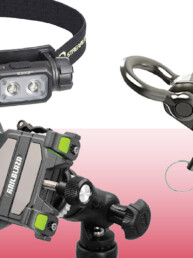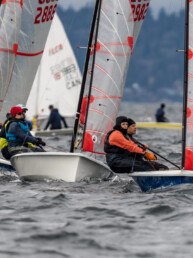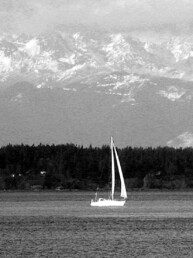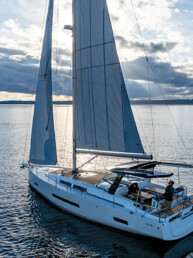
Back in 2016, the Dock was the place to be. Designed for launching kayaks and rowing shells on an urban stretch of the Willamette River in Portland, it soon became the de facto summer sunbathing spot for the city’s young and beautiful. Arriving early on a Saturday morning, I would push my rowboat down the gangway on its wheeled cart, mount my oars, slide the boat into the water, and row away.
The Dock’s 100-foot gangway led to a grippy fibergrate landing attached to a wave-washed wooden dock that sat about four inches above the river’s surface. This final section provided easy access to the Willamette without the headache of competing with motor boats and their macho trucks at the launch ramp a few miles upstream. But sunbathing hipsters made returning to the Dock later in the day a challenge. As I noted in a 2016 article: “I pulled up alongside the dock in the shadow of the Hawthorne Bridge in my rowboat and there they were, feet dangling in the water, sunglasses hiding their faces, staring towards downtown. Do they even notice me? I think not, because when I attempt to bring my boat to the edge, they don’t budge.”
Looking back now, it’s hard to believe there was a time when scantily clad, tattooed young people were the biggest obstacle to accessing the Dock.
In 2019, the non-profit Portland Boat House (PBH) reached the end of its lease in a building at the top of the riverbank near the Dock, where it had served as a home base for various rowing clubs and as a small boat storage area. With the PBH gone, the bustle of crews carrying 10-person shells and long oars to the river was no more. A few dragon boat teams still moored there. While a few recreational kayakers and canoeists could be found on nice weekends throughout the year, the Dock’s fortunes had turned.
In April 2020, conditions reached a new level of absurdity, when someone drove a car onto the Dock. I didn’t believe the story at first. The Dock was a tight space, one where someone carrying a canoe could just squeeze past another person on the ramp. How could a vehicle have made it past the bollards, along the waterfront path, around a 90 degree turn, down the gangway, and along two sections of dock? Then a grainy picture appeared on the Internet. There it was: a black compact car improbably parked about 15 feet from the end of the Dock, its front wheel jauntily dipping into the river.
Maybe the car was the final straw for the lowest portion of the Dock. Gazing at it from a nearby bridge 10 months later, I could see that this section was holding on by a thread of chain. The Willamette coursed over it, and for a few forlorn days it bobbed up and down like a leaf in the current. Surely someone in charge had noticed and would come to the rescue? Alas, the low-freeboard section simply disappeared, never to return.
With the pandemic, the Dock became the closest place for many of Portland’s inner eastside residents to launch a small boat, and the space took on a new life. Offering an escape from the grind and fear of illness, the Dock was vital once more. But its increasing decrepitude made access a continual challenge for small boat folks. The sandpaper finish of the remaining fibergrate deck, so useful for walking on a wet day, was a mortal threat to small boats. Nevertheless, we persisted. I laid an old bath mat on the edge of the dock, using it as a protective cushion when I slid my rowboat into the water. Boaters with old beater canoes simply shoved them right off the edge, the new scrapes adding character. A few dragon boats remained, secured to the dock with locks and cables, their crews showing up when health conditions allowed.
As the pandemic waned, summer hipster sunbathers returned, albeit in smaller numbers. Kayaks came back, too, and teenagers like my son and his friends, who didn’t hesitate to dive into the Willamette’s waters to escape the heat. Bright beach towels and pink flamingo inflatables brought life and color to the scene. All that activity, compressed into a smaller space, made it even harder to get in and out of the water, but I was grateful for the positive presence.

The last time I went to the Dock, it was mid-winter. The river was the color of coffee with a generous helping of milk. Blackberry vines had grown across a portion of the gangway, graffiti marked the pilings, and I was reluctant to walk down to the bottom. The current pushed messy piles of sticks, branches, and trash against what remains of the Dock. A bevy of homeless boaters had pulled anchor and taken over the perimeter to avoid being washed downstream. The sound of a tattered sail flapping in the wind sent me hurrying back up to the riverside trail.
Recently, hope for the Dock’s revival emerged with a proposal in the Portland City budget for a project intended to address issues of equity and racial justice around access to the Willamette, including funds for habitat restoration, a trail— and acquisition and replacement of the Dock, currently owned, but scarcely maintained, by a local business association.
This discovery brought me back to a hopeful moment from early fall, when the dock was mostly deserted again, save for what appeared to be a skateboard ramp pointing off the end. I puzzled over this for a few days, until I ran into a colleague at work and we started talking about his childhood.
“Yeah, we didn’t have enough money for boats when I was a kid,” he said, “but we still used the river a lot.” When they outgrew their bikes, he told me, he and his friends turned them into “river bikes,” using them to launch themselves off a dock and into the water.
“But how did you get the bike back out?” I asked.
“Oh, we just tied a life preserver over the handlebars and hauled it back to shore.”
At that moment, I figured out what that ramp was doing on the Dock. Sure, it took up real estate for sunbathers and boaters, but it meant that people were figuring out different ways to enjoy the river.
Isn’t that the whole point of having a dock?
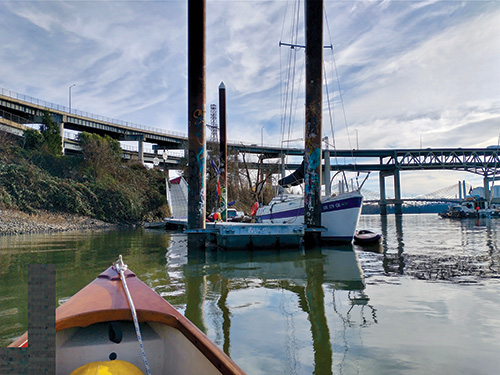
Bruce Bateau sails and rows traditional boats with a modern twist in Portland, Oregon. His stories and adventures can be found at www.terrapintales.wordpress.com.
Bruce Bateau
Bruce Bateau sails and rows traditional boats with a modern twist in Portland, Ore. His stories and adventures can be found at www.terrapintales.wordpress.com

